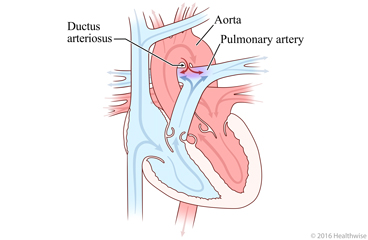
What is a patent ductus arteriosus?
Patent ductus arteriosus (PDA) is a type of congenital heart disease. Congenital heart disease refers to heart problems a baby is born with.
In PDA, an opening near the heart called the ductus arteriosus fails to close after birth. ("Patent" means open.)
The heart has two major blood vessels attached to it: the aorta and the pulmonary artery.
- The aorta carries oxygen-rich blood (red blood) from the heart to the rest of the body.
- The pulmonary artery carries low-oxygen blood (blue blood) from the heart to the lungs to pick up oxygen.
Before birth, your baby (fetus) lives in amniotic fluid. So your baby doesn't breathe through the lungs. Instead, the ductus arteriosus helps the baby's body get red blood from the mother. Normally this opening closes shortly after birth because the baby doesn't need it anymore.
If the opening stays open, some of the red blood in the aorta flows back into the pulmonary artery and to the lungs instead of to the rest of the body. Because some of the red blood that was supposed to go to the body is going to the lungs, the heart may have to pump harder to get red blood to the body.
But sometimes a PDA is so small that the heart doesn't have to work harder and there are no symptoms.
It can be scary to learn that there is something wrong with your baby's heart. The hospital staff understands this. They will explain what happens and will answer your questions.
How is PDA diagnosed?
Your doctor may hear abnormal heart sounds, such as a heart murmur, when examining your newborn.
Your doctor will order tests to find the cause of abnormal sounds or of symptoms. The most common test used to identify this problem is called an echocardiogram, or "echo" for short. It uses sound waves to make an image of your baby's heart.
Your baby may have other tests, such as an EKG (electrocardiogram), chest X-ray, and checking the amount of oxygen in the blood.
What are the symptoms?
Symptoms depend on how big the opening is. Babies with a mild PDA have smaller openings. These babies may not have symptoms.
But if the opening is larger, symptoms may include:
- Fast breathing.
- Sweating while feeding.
- Not eating well.
- Being fussy a lot of the time.
How is it treated?
In mild cases, the opening may close on its own. It may take from a few days to several months. No treatment is needed.
And treatment is usually not needed if your baby has no symptoms.
What can you expect?
Your doctor will explain what symptoms to watch for at home. Regular checkups will help your doctor watch your baby for symptoms over time.
Follow-up care is a key part of your child's treatment and safety. Be sure to make and go to all appointments, and call your doctor or nurse advice line (811 in most provinces and territories) if your child is having problems. It's also a good idea to know your child's test results and keep a list of the medicines your child takes.
Where can you learn more?
Go to https://www.healthwise.net/patientEd
Enter T452 in the search box to learn more about "Learning About Mild Patent Ductus Arteriosus in Newborns".
